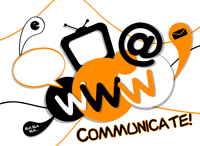Developing an effective Communications Plan for your organization can seem like a daunting task. Where do you start? What’s involved in developing effective communications between your organization and its audiences?
 Step #1: How will your organization communicate?
Step #1: How will your organization communicate?
The first element of any effective Communications Plan is determining how your organization would like to communicate with its audience. Optimally, your organization will utilize a variety of different media including traditional paper-based formats as well as the newest and most-relevant social networks.
The current environment of the Internet may feel like your organization should be constantly talking to its audience using Facebook, Twitter, Instagram, Snapchat, or any of a variety of other new and upcoming social networks, and, although that may be true for your organization, you also must remember to communicate to the members of your audience who don’t use social networking.
In addition to using social networks (edTactics recommends your organization at least uses Facebook and Twitter), you should continue sending emails (newsletters or just email messages) and even paper-based traditional media such as letters, postcards, or paper newsletters to communicate with your audience.
 Step #2: When should your organization communicate?
Step #2: When should your organization communicate?
Inventory your organization’s regular communications assets including reports, activities, announcements, and more. Design a calendar for when your organization will communicate the different elements you have in your repertoire.
Effective Communications Plans include releases that go out annually, quarterly, monthly, weekly, and even daily. If your organization releases an annual report, naturally, you would send that out once a year, preferably using a combination of paper-based and electronic methods such as releasing the report on your website and then posting a link to your Facebook and Twitter accounts as well as mailing it directly to your audience.
If your organization has a lot to talk about such as ongoing activities or news stories, consider using Facebook, Twitter, and your website to get the word out on a weekly or even daily basis. However, we recommend that you limit Facebook and Twitter posts to one-a-day; posting too frequently may cause your audience to stop following you as they might see too many posts from your organization as annoying or “noisy.”
 Step #3: Remember your organization needs to listen and respond to your audience.
Step #3: Remember your organization needs to listen and respond to your audience.
Social networks are a two-way street. Your organization needs to remember to pay close attention to your social networking accounts. Reply promptly to any questions or concerns your audience may bring to your attention. If you ignore your audience’s inquiries on social networks, your audience may become frustrated and badmouth your company, or, worse yet, turn to a competitor for their services.
 Step #4: Don’t be afraid to ask for help.
Step #4: Don’t be afraid to ask for help.
edTactics offers a variety of Communications Strategies services including:
- Effective short- & long-term Communications Plans
- Campaign Timeline Development
- Traditional Media & Social Networking
- Develop & Maintain Two-Way Community Communication
Send us an email or give us a call at (800) 983-8408 to learn how we can help you become more effective at communicating with your audience!
Sincerely,
Art Edgerly & Eric Jacobson
Co-Founders of edTactics
Call us at (800) 983-8408
Like us on Facebook at www.facebook.com/edTactics
Follow us on Twitter at www.twitter.com/edTactics
